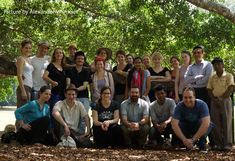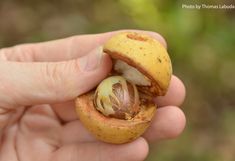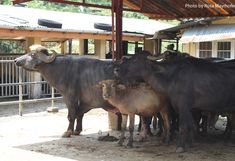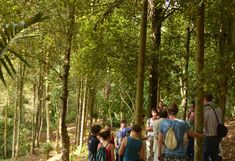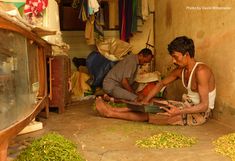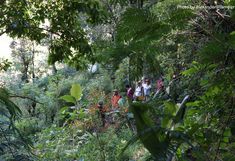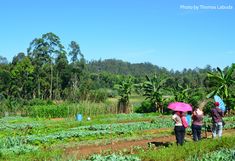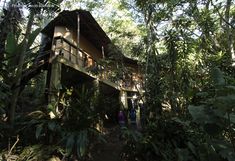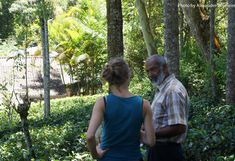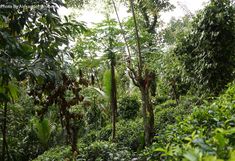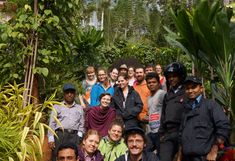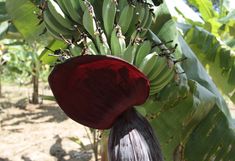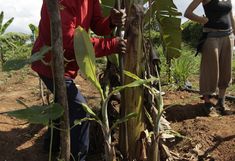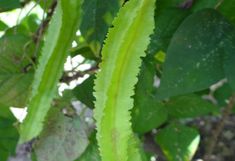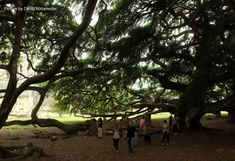Wo der Pfeffer wächst - Interdisziplinäre Exkursion nach Sri Lanka
Achtzehn Studierende der BOKU befinden sich vom 8. bis zum 20. Februar 2015 auf einer Tropenexkursion zum Thema Biologische Landwirtschaft in Sri Lanka mit Exkursionsleiter Friedrich Leitgeb vom Institut für Ökologischen Landbau. In Kooperation mit der landwirtschaftlichen Fakultät der Universität von Peradeniya werden biologische Gewürzgärten, Teeplantagen, Reisfelder, Waldgärten und Permakulturbetriebe besucht. Für alle, die neugierig auf die Erfahrungen und Erlebnisse der Teilnehmerinnen und Teilnehmer sind, gibt es hier ein Online-Tagebuch der Exkursion mit täglichen Berichten aus Sri Lanka (in englischer Sprache). Bitte jeweils das Foto anklicken um die ganze Galerie zu sehen.
WEBLOG
18. & 19.2.2015: Days TEN & ELEVEN Our last day in Peradeniya started with reflections about the program. Our counterparts wanted us to give feedback on the program to know what could be improved for future programs. After some free time, we were heading towards our Beach resort. On the way we had refreshing King Coconut and made a short visit on a rubber plantation. The rubber from the trees can be harvested 2-3 times a day around 10 month a year. Rubber is one of the main export products of Sri Lanka, but unfortunately we did not get the full insight in its production on this field trip. The last 10 days were exciting and filled with an interesting program. So there was definitely the need for an internal reflection on our experiences and impressions to consolidate our knowledge. Therefore a group of students organized a well prepared workshop on Thursday morning. That was the official end of our excursion on organic agriculture in Sri Lanka. At the end it was time for a බොහොම ස්තුතියි (bohoma stutiyi means “thank you”) and a lovely good bye from our counterparts Dr. Janak Vidanarachchi, Prof. Ananda Jayakody, Prof. Buddhi Marambe and Iresha and Sachinthaka. We sang ‘I have a dream’ from Abba, the song that followed us as Janak ringtone through the whole trip.
Off the official program were invited to visit the first organic food store in Colombo. We enjoyed a welcoming atmosphere with motivated staff members at the Good Market shop. Dr. Amanda Kiessel gave us further insights into the organic farming movement of Sri Lanka. Finally, we were able to buy some organic tea and spices at the shop. On Saturday three of us visited the Good Market fair close to the shop which is a meeting point for people interested in sustainable development. Organic farming and food are integral parts of this volunteer-driven initiative. Concluding our field trip we can say that we had a wonderful time on the “Pearl of the Indian Ocean”, thanks to all the participants, farmers, and actors of the organic farming movement and of course those who made this excursion possible!
17.2.2015: Day NINE On our 9th day we had a break from sitting in the bus and could enjoy the spirit of the University of Peradeniya again. Professor H.M.D.R. Herath presented a lecture about religion, culture and agriculture in Sri Lanka. Due to his research he is an expert about rituals and traditions related to agriculture in Sri Lankan. Especially small scale farming is strongly related to religion. To pray for good harvest is very common in rural areas. Professor Herath explained one ritual in detail, which is to fight harmful insects in paddy fields. In the case of pest infestation, every farmer of the community gives some rice of the last harvest and they cook milk rice together. Then the farmers scatter the milk rice on their fields. This ritual goes hand in hand with praying and spelling. In the end farmers leave the fields with clapping hands. For the following 3 days nobody is allowed to go there. The birds hear this clapping and as this ritual is an ancient practice, they know nobody is going to disturb them in eating the milk rice – and the insects. Such rituals are practices collectively and contribute to social coherence within the village.
During our field trip in Sri Lanka, we often heard about Rudolf Steiner and biodynamic farming. To answer some of our questions concerning the link between biodynamic and traditional farming and the today’s organic farming movement, Mrs. Dr. Wimala Dewanarayana gave us an insight on biodynamic farming. Traditionally, and due to religious beliefs, farming in closely related to moon cycles and cosmic influences. Astrology is often considered for agricultural practices.
Before lunch we could see the livestock of the University of Peradeniya. For teaching and research purposes the Faculty of Agriculture keeps small stocks of cattle, buffalo, goat, sheep, rabbit, chicken, duck, turkey, quail and even two crocodiles. Some of the products are available at the University Shop. Our favourite was definitely the homemade ice cream!
For lunch we had the typical rice and curry. Sri Lankan diet consists of rice - 3 times a day. Usually people use their right hand instead of cutlery. Food really tastes different this way. Of course we all know already how to eat properly with our fingers, Iresha and Sachinthaka, the two graduated students accompanying us, tought us very well.
The afternoon we spent in another typical Kandyan Forest Garden where the owner Mr. Waligama and his farm workers were busy with harvesting cloves (Syzygium aromaticum). In the evening we could enjoy some free time in Kandy, strolling through markets and along the Kandy Lake. The end of our fieldtrip comes closer.
16.2.2015: Day EIGHT
The 8th day started with a visit to the Geragama Tea Factory. First Dr. Gamini Pushpakumara explained us the most important facts about the factory and tea processing. Mr. Roshan Obeyseker, the manager of the Geragama Tea Factory, kindly gave us permission to inspect every step throughout the production process. The Geragama Tea Factory was built in 1903 and consists of the factory itself and 500 ha tea estate. It produces mainly black tea and can process up to 9000 kg of green leaves per day. The fresh tea leaves are brought to the factory twice a day. The green leaves are spread out for 14-18 hours on large metal grids where dry air is used for the withering process. This step is very important for further processing, as too high leaf moisture would cause a loss of important substances. After the withering, the rolling process starts in which the leaves are grinded into little tea size particles. For black tea the next step is fermentation. This chemical reaction results in a change in color and taste. For green tea the fermentation is skipped and the drying process starts directly. In the next step the fiber of the tea leaves are separated. This side product is used as fertilizer in the tea gardens. The last station is the grading room. Various machines separate the different particles according to size, color and shape. Through the combination of these three properties the taste of the tea varies and therefore results in 18 different types of black tea e.g. B.O.P., better known as English breakfast. After the factory we visited a governmental institution belonging to the Department of Agriculture responsible for marketing food products. This organization helps small local farmers to develop their livelihoods by assisting the conversion to sustainable food production as well as promoting and commercialization of their products. The farmers can get different trainings regarding sustainable agricultural. Although farmers are not certified organic products are sold in the institutions Organic Food Preparation and Sales Unit labeled as “Organic through Trust”. The organization’s mission is to establish a sustainable cropping system with the participation of the farming community. The next visited the Gami Seva Sevana farm and training center. It accounts for many as the birth place of organic agriculture in Sri Lanka. It was registered as a non-governmental organization in 1981 and ever since promotes organic agriculture. Their trainings featured soil and biodiversity conservation, animal husbandry, agroforestry, biodynamics, permaculture, vermi compost and chemical free food processing. However, Gami Seva Sevana became less important in the course of time and is not the headquarters of the organic movement in Sri Lanka anymore. The last visit of that day brought us to one of the famous Kandyan Forest Gardens. 25 years ago Mr. Pillai started with his 2 ha forest garden next to his house and is now certified organic. The garden is located in the mid-country wet zone. In the upper stories of vegetation he cultivates Areca nut (Areca catechu), coconut (Cocos nucifera) and Jackfruit (Artocarpus heterophyllus). The midlevel houses nutmeg (Myristica fragrans), clove (Syzygium aromaticum), pepper (Piper nigrum), coffee (Coffea sp.), cocoa (Theobroma cacao), tea (Camellia sinensis) and a variety of other cash crops and plants. Mr. Pillai also produces his own organic charcoal which he uses as water and nutrient binding elements in plant pots in his plant nursery. He holds profound knowledge about organic plant protection and ecosystems. One of the mayor challenges in his forest garden are the wild monkeys which appreciate very much the vegetables free of chemicals. By intercropping vegetables with hot chili plants (Capsicum annuum) he provides some “hot” experiences when the monkeys try to steal his harvest. All in all Mr. Pillais Kandyan forest garden is a model for other small scale farmers in the area and he is therefore often contacted even by the government for trainings and consultancy.
-
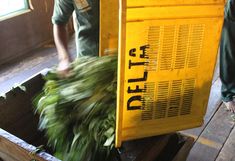 5 Bilder
5 BilderA tea factory worker sends the tea leaves to the next processing step. -
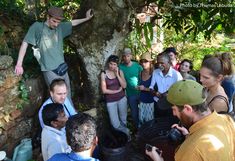 5 Bilder
5 BilderMr. Pillai explains how he makes his own charcoal. -
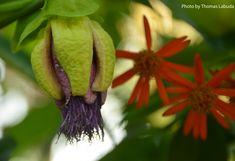 5 Bilder
5 BilderThe overmature flower of passionfruit -
 5 Bilder
5 BilderThe excursion group visits the sales unit of the Department of Agriculture. -
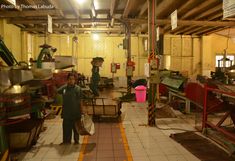 5 Bilder
5 BilderWorker at the tea leaf grinder in the Giragama Estate tae factory
15.2.2015: Day SEVEN After a chilly night at Belipola, the sun and warmth at the organic farm Mihimandala (“Mother Earth Farm”) was what we needed for a cheerful continuing of our field trip. The manager of this farm, Mr. Athula Priynatha, has already been our companion at previous farm visits. On this farm he concentrates on the production of fresh vegetables for the Sri Lankan market. The agricultural land of the farm is divided into 8 plots of each approx. 0,5 ha. For each plot there is a manager responsible for the production. In addition to the regular salary, the manager earns 20% of the outcome profit of the plot, which aims for increasing the motivation. Athula Priynatha’ mission is to promote organic farming in his neighborhood. To achieve that he helps other farmers in the conversion process by providing seeds, knowledge and a marketing channel for the products. Our next visit was a meeting with Mr. Kulatunga, the manager of the Marginalized Organic Farmers Association (MOFA). This Association is similar to SOFA, which we visited two days ago. MOFA was founded in 2011 to establish a link between medium size farmers and export enterprises such as Biofood Ltd. In this area we visited MOFA farmers who mainly produce organic tea as a cash crop and also benefit from Fairtrade premium prices. At the meeting we had the opportunity to talk to some farmers of the Association. Mr. Kulatunga and the farmer explained us how the Fairtrade bonus money we pay as consumers is distributed among the producers and that it is a valuable contribution for their life and agriculture. The premium money is not paid directly to the farmers. Therefore each farmer can state what he or she needs for improving their livelihoods and for improving tea production. Another benefit of MOFA is that it contributed to community development, i.e. Buddhist, Hindus and Muslims come together and interact in a respectful way. In the afternoon we visited the Analog Forestry project in Belipola. Now the low temperature in the shade of the trees had a refreshing effect on us. Analog Forestry is a forestry concept which tries to establish a highly biodiverse forest-ecosystem and is set into practice predominantly in tropical regions. These systems are similar to natural forests, which provide a huge number of different habitats for plants and animals. The focus of analog forestry is rather on biodiversity than on producing food, so a clear distinction to agro-forestry can be made. The project in Belipola was established in 1983 by the system ecologist Dr. Ranil Senanayake, who developed and tested the concept of Analog Forestry here in the upcountry of Sri Lanka. Today Trudy and Sion manage Belipola. Since a few months the couple and their approx. 10 workers grow also organic salads which they sell to the Good Market, the first organic shop in Colombo. For becoming economically more self-sustaining Trudy and Sion try to attract more tourists and volunteers to stay with them in Belipola. After a wonderful day in European-like climate conditions our long bus trip home to Peradeniya was sweetened by wonderful views of the Sri Lankan upcountry.
14.2.2015: Day SIX In the gardens of the Tea Research Institute (TRI) in Talawakelle Dr. Mohotti explained about the tea plantations in Sri Lanka. Tea is not a native crop in Sri Lanka, but was brought from India around 1860 as a substitiute for coffee due to plant disease which affected most areas of the island. Tea is a so called rainfed crop and requires special soil conditions (pH value of 4,5-5,5) as well as a certain degree of shade. The institute cultivates organic and conventional plantations for research purpose and commercialization. At the beginning, the yield of organic tea fields is lower than in conventional plantation, but after around six years the yield reaches the same level and can get even higher. Dr. Mohotti explained this phenomenon as a result of higher biodiversity in organic tea production. In Sri Lanka most of the tea is plucked by hand, which ensures higher quality compared to mechanical harvest in China and tea producing countries in Africa. Depending on the temperature it is necessary to pluck the leaves every 7-10 days, in lower and warmer regions even every 3-5 days. The tea plucking is exclusively done by women. The average income of a tea plucker at the institute is about 690 rupees per day which equals around €4,50. In addition, the institute provides meals and housing for the workers. In Nuwara Eliya we visited the organic vegetable farm of Mr. Hettiarachchi. The farm is certified under the Sri Lankan Standard Institute for organic farming (SLSI). Due to the special climate in the mountainous Nuwara Eliya (over 2000 meters ASL) is also called Little England. As a result, vegetable crops we know from Austria can be grown in this area. Mr. Hettiarachchi showed us his fields where he cultivates several herbs, e.g. chives (Allium schoenoprasum), parsley (Petroselinum crispum) and vegetables like carrots (Daucus carota), beetroot (Beta vulgaris sp.), leek, lettuce, cabbage. For Mr. Hettiarachchi there is a very strong link between agriculture and religion. As in Buddhism killing any being is prohibited, he rather lets snails and insects eat his salad and cabbage than to use organic insecticides. It was impressive how he organized his fields in narrow terraces, so he can use his steep land but so in case of heavy rainfall doesn´t suffer landslides and big yield losses. Mr. Hettiarachchi sells his vegetables only on the Sri Lankan market. A large amount of his products he sells to Supermarkets in Colombo.
For the night we split up the group, one part sleeping at Mr. Athula Priyantha’s organic farm, the others found beds in the forest of Belipola, where the frosty temperatures (10°C) kept us from sleeping.
-
 4 Bilder
4 BilderA worker at the vegetable farm of Mr. Hettiarachchi. On a plot in the background Agapanthus leaves protect germinating seeds. -
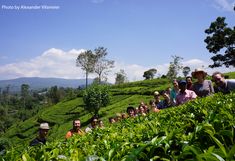 4 Bilder
4 BilderThe excursion group in the organic tea garden at the Tea Research Center. -
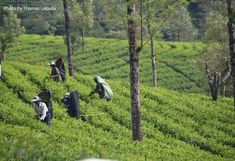 4 Bilder
4 BilderTea plucking in the upcountry of Sri Lanka. -
 4 Bilder
4 BilderThe excursion group visits the vegetable fields of Mr. Hettiarachchi.
13.2.2015: Day FIVE Day 5 started with a lecture about the certification system in Sri Lanka. For this purpose two officers of the Control Union Inspections (Pvt) Ltd., Mr. Wickremarachchi and Mr. Rajapaksha, explained their work in the certification processes. Mr. Thilak Kariyawasam introduced us to his organization, the Lanka Organic Agricultural Movement (LOAM). We also learned about Participatory Guarantee Systems (PGS). Finally Mr. Athula Priyantha further described the challenges of the certification system in Sri Lanka. After lunch Mr. Sri Kantha held a short presentation about the Small Organic Farmers Association (SOFA). SOFA is an umbrella organization consisting of 51 farmers groups all over Sri Lanka. Certified under the fair trade premium program the approximately 2600 farmer members produce mainly tea (Camellia sinensis), coconut (Coco nucifera) and rice among many other crops. With the money from the fair trade premium program the organization supports the members with free planting material, farm animals and agricultural equipment. The association also provides training and advisory and also runs other social programs for community development. To get an immediate impression of their work we were able to visit an organic tea garden of a small scale farm in Gampola. The farm is about 0.5 ha size. Intercropping with spices such as pepper (Piper nigrum) and vanilla (Vanilla planifolia) as well as fruits like papaya (Carica papaya) and coconut resulted in a higher biodiversity. Composting and a successful production of wormy wash as fertilizer were the most intriguing aspects that we were able to observe in the tea garden. Especially the wormy wash production caught our attention. In this process water is slowly moving through a barrel filled with gravel, sand, soil and earth worms to collect the nutritious substances exuded by the worms which is used as liquid fertilizer.
12.2.2015: Day FOUR After an overnight stay in a mosquito stronghold, we started the 4th day of our field trip (12th February 2015) with a special breakfast in a bakery. Then we visited the organic certified farm GoGreen Rajarata near Anuradhapura. In 2014, Mr. and Mrs. Wanninayake decided to invest in Sri Lankan organic agriculture and bought 4 ha of land to grow vegetables for the domestic market. One of their motives was their concern about the wide spread chronic kidney disease in Sri Lanka which results from the high usage of pesticides in agriculture. The know-how necessary for organic production comes from their consultant Mr. Athula Priyantha, who successfully manages his own organic farm since 1990 and is one of the key persons for organic agriculture in Sri Lanka. The vegetable farm is a good example for intercropping in the dry zones of Sri Lanka. In the shade of banana (Musa sp.) grow crops like chili pepper (Capsicum annuum), eggplant (Solanum melongena) and other herbal plants. On other plots grow more sun demanding plants like passion fruit (Passiflora edulis), papaya (Carica papaya), tomato (Solanum lycopersicum), ginger (Zingiber officinale) and winged bean (Psophocarpus tetragonolobus). Sri Lanka has an old and widely extended water system for agricultural purposes. But since the green revolution agrochemical pollution is a problem, especially for organic farmers in the dry zone. Therefore the GoGreen farm has its own rainfed well, however they have to manage the water use carefully and water is the limiting production factor. We had the opportunity to help the farm workers to prepare an organic liquid fertilizer. For this we cut the leaves of papaya, neem (Azadirachta indica), Basil (Ocimum sp.), Pavatta (Pavetta indica), Jatropha (Jatropha sp.), Soursop (Annona muricata) and Nika (Vitex negundo) into little pieces and added cow dung. To let some detrimental compounds to be adsorbed on to clay - as clay could function as a chemical filter - we added a handful of clay from a termite hill. After soaking in water for 14 days the filtered liquid fertilizer is ready for application and has additionally repellent functions against insects for approximately 10 days. During the whole day we had interesting discussions about organic farming in Sri Lanka and challenges for the movement. At the end we assisted in banana transplanting: we removed the banana sucklings from the mother plant and planted a new row in the divers intercropping system. We left the farm and spent a couple of hours in the bus. It was a long journey and everybody was glad to stop for drinking a fresh coconut. Finally we arrived at the Gal Bungalow.
11.2.2015: Day THREE On the third day of our field trip we went north towards the dry zone of Sri Lanka. In the region of Matale we visited the organic spice garden Euphoria. In this area are many spice gardens open for visitors, however, only very few are managed organically. In the spice garden grows pepper (Piper nigrum), lemongrass (Cymbopogon citratus), ginger (Zingiber officinale), cinnamon (Cinnamomum verum), cardamom (Elettaria) and clove (Syzygium aromaticum) under the shade of the high trees. The manager cooperates with Biofoods (Pvt) Ltd., a processing company which buys the raw products for export and additionally provides advisory service to ensure high quality spices. After that we moved on to Seethavally Biodynamics, a farmer’s association and training center for organic agriculture. On the 22.6 ha of paddy fields around 70 farmers produce various traditional Sri Lankan rice varieties for export through Biofoods Ldt. and for the local marked. Beside the paddy production the farmers’ association employs the surrounding farmers to grow a row of cash crops like Turmeric (Curcuma longa), banana (Musa sp.), papaya (Carica papaya), ginger, pineapple (Ananas comosus) and chili pepper (Capsicum annuum). Our last visit on this day was the Biofoods Ldt. processing factory. The managers explained and showed us the process of pepper refinement: sorting, washing, sterilization and finally packing for export to Europe, Australia, Japan and North America. In addition to pepper this factory processes nutmeg (Myristica malabarica), curcuma, vanilla (Vanilla planifolia) and cardamom. Lately Biofoods Ldt. has invested in new facilities to shock freeze herbs like lemon grass in liquid nitrogen and export for the western marked. We spent the night in the historically and culturally important city of Anuradhapura.
-
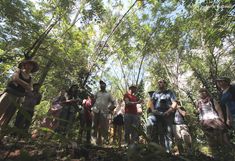 5 Bilder
5 BilderThe fieldtrip group in the shade of the high trees of the spice garden Euphoria -
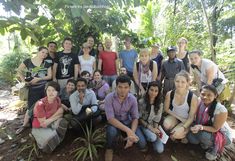 5 Bilder
5 BilderThe excursion group together with a Biofoods cosultant, the manager of Euphoria spice garden -
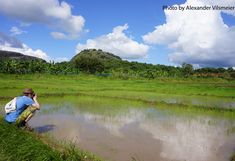 5 Bilder
5 BilderInspection of a newly transplanted paddy field -
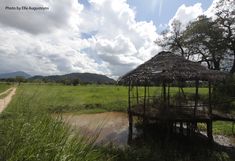 5 Bilder
5 BilderOrganic paddy fields at Seethavalley Biodynamics -
 5 Bilder
5 BilderPaddy field visit
10.2.2015: day TWO After picking up our counterparts Dr. Vidanarachchi and Prof. Jayakody we continued our fieldtrip with a visit in the famous royal botanical garden of Peradeniya. Mrs. Dr. Herath was so kind to show us and explain the major tasks of the botanical garden. The vision is to become the most diverse and aesthetic botanic garden of Asia with one focus on preserving endangered and endemic plant species. This is partly done by in-vitro cultivation, a process we could watch in the laboratory. The Botanical garden reproduces a species of Impatiens, which is extinct in Sri Lanka due to over collection. The botanical garden is not fully managed organically, however, the main fertilizer is organic leaf compost produced on site. The compost production serves also an educational purpose - here different ways of leaf composting processes are exercised, showing how they work both in the dry and the wet-zone.
The coconut palm (Cocos nucifera) is a valuable plant in Sri Lanka and all its parts are used in some way. For commercial cut flower production, mainly Anthurium, coconut husk is used as a potting substrate, because it is very effective for water retention. The botanical garden is also known for its huge population of fruitbats. During the day thousands of bats rest and hang in the trees along the river Mahaweli .An impressive moment! In the afternoon we visited the Agrotechnology Park of the Department for Agriculture in Kandy. It is exhibition ground for education, receiving around 10,000 visitors per year. A few years ago the government started a program to underline the importance of homegardens for national food security. Sri Lankan homegardens show a variety of vegetables such as Ladyfinger (Abelmoschus esculentus), Snake-gourd (Trichosanthes cucumerina), chili-pepper (Capsicum annuum), eggplants (Solanum melongena), Cabbage (Brassica sp.) and many more. The garden is surrounded by trees like neem (Azadirachta indica), papaya (Carica papaya), coconut palm (Cocos nucifera), coffee (Coffea sp.), starfruit (Averrhoa carambola), kitul tree (Caryota urens). At the end we visited the small museum about traditional agriculture and tools. The exhibition stressed the importance of religion and rituals within agricultural practice. For example for the post-harvest ritual kiripidu the first harvested rice is offered as milk-rice to Buddha. We closed the day by attending the evening ceremony in the sacred tooth temple in Kandy. Bhavatu sabba mangalam (May all beings be happy)
-
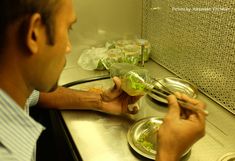 5 Bilder
5 BilderAn employee of the Botanical Garden of Peradeniya is multiplying endangered and endemic plant species by using in-vitro cultivation methods. -
 5 Bilder
5 BilderDr. Herath explains us the different ways of leaf composting. -
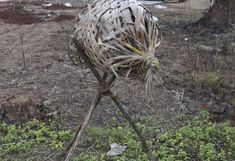 5 Bilder
5 BilderA ritual item which ensures the safe and successful construction of a farmer’s house. -
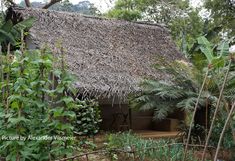 5 Bilder
5 BilderA farmer’s house surrounded by a homegarden in the Agrotechnology Park Kandy. -
 5 Bilder
5 BilderThe famous tooth temple in Kandy.
8. & 9.2.2015: Welcome & Day ONE Sunday afternoon all 18 participants of our excursion on organic agriculture in Sri Lanka dropped in at our accommodation at Gal Bungalow, the Guest house of our hosting University in Peradeniya. The forest surrounding the estate is filled with sounds we know only from documentaries on television. We were heartily welcomed by our counterparts Prof. Buddhi Marambe, Dr. Janak Vidanarachchi and Prof. Ananda Jayakody, who gave us main organizational information about the next 12 days and were really concerned to answer all our open questions. From now on and until the end of the excursion Iresha Pathirana and Sachinthaka Abenywickrema, two graduated students of animal science, are going to accompany us. On the first day of the excursion we were officially welcomed at the Faculty of Agriculture by the vice-chancellor, Prof. Atula Senaratne and the dean of the faculty Prof. K. Samarasinghe as well as by the heads of every department. Then we had interesting lectures on tropical agriculture, biodiversity, the diverse agro-climatic conditions in Sri Lanka and organic farming in the global context and in Sri Lanka. The island has got 46 agro climatic zones, from dry low land with less than 1000mm rainfall in the east up to wet high lands with more than 5000mm in the west. That is the reason for the high biodiversity on the island in the Indian Ocean. In Sri Lanka all botanic orders are represented and a high number of species are considered to be endemic. The organic farming movement in Sri Lanka is still relatively small and predominantly export orientated. During the next 10 days we will find out more out about organic farming practices and local knowledge in Sri Lanka. We thank Dr. Punyawardena, Prof. Pushpakumara, Mr. Thilak Kariyawasam and Dr. Gamini Hitinayake for the interesting lectures. After finishing the lectures we got a guided tour on the campus of the University of Peradenyia and learned about the educational system in Sri Lanka. Around 2% of the population get access to the university, which then provide free accommodation and education. Each year 240 new students start their studies at the faculty of agriculture. During the breaks we tasted delicious Sri Lankan curries, specialties and tee.

